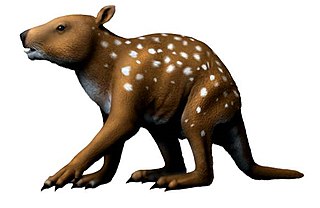
Obdurodon is a genus of extinct platypus-like Australian monotreme which lived from the Late Oligocene to the Late Miocene. Three species have been described in the genus, the type species Obdurodon insignis, plus Obdurodon dicksoni and Obdurodon tharalkooschild. The species appeared much like their modern day relative the platypus, except adults retained their molar teeth, and Unlike the platypus which forages on the lakebed, they may have foraged in the water column or surface.

The order Peramelemorphia includes the bandicoots and bilbies; it equates approximately to the mainstream of marsupial omnivores. All members of the order are endemic to the twin land masses of Australia-New Guinea and most have the characteristic bandicoot shape: a plump, arch-backed body with a long, delicately tapering snout, very large upright ears, relatively long, thin legs, and a thin tail. Their size varies from about 140 grams up to 4 kilograms, but most species are about one kilogram, or the weight of a half-grown kitten.

Thylacinidae is an extinct family of carnivorous, superficially dog-like marsupials from the order Dasyuromorphia. The only species to survive into modern times was the thylacine, which became extinct in 1936.

Thylacoleonidae is a family of extinct meat-eating marsupials from Australia, referred to as marsupial lions. The best known is Thylacoleo carnifex, also called the marsupial lion. The clade ranged from the Late Oligocene to the Pleistocene, with some species the size of a possum and others as large as that of a leopard. As a whole, they were largely arboreal, in contrast to the mostly terrestrial dasyuromorphs, monitor lizards and mekosuchines.

Palorchestes is an extinct genus of terrestrial, herbivorous marsupials of the family Palorchestidae. The genus was endemic to Australia, living from the Miocene through to the Pleistocene epochs.
Wakaleo was a genus of medium-sized thylacoleonids that lived in Australia in the Late Oligocene and Miocene Epochs. Although much smaller than its close relative, the marsupial lion, Wakaleo would have been a successful hunter. It had teeth specially designed for cutting and stabbing. The genus is from an extinct family of Vombatiformes, so it is distantly related to the herbivorous wombats.
Wakaleo vanderleuri is a species of marsupial lion of the genus Wakaleo, that lived in Australia during the Miocene.

Ekaltadeta is an extinct genus of marsupials related to the modern musky rat-kangaroos. Ekaltadelta was present in what is today the Riversleigh formations in Northern Queensland from the Late Oligocene to the Miocene.
Wakaleo oldfieldi is an extinct species of marsupial lions of the genus Wakaleo, found in the Cenozoic deposits of South Australia. It had three unfused molar teeth instead of two fused molars as is the case with the Pleistocene Thylacoleo carnifex.
Maximucinus muirheadae is the largest known thylacinid species that lived in Queensland, Australia from the late Oligocene to the middle Miocene. The species was a quadrupedal marsupial predator, that in appearance looked similar to a dog with a long snout. Its molar teeth were specialized for carnivory; the cups and crest were reduced or elongated to give the molars a cutting blade. It is estimated to have weighed about 18 kilograms.
Wabulacinus ridei lived during the early Miocene in Riversleigh. It is named after David Ride, who made the first revision of thylacinid fossils. The material was found in system C of the Camel Spurtum assembledge.
Wakaleo alcootaensis was a species of marsupial lion of the genus Wakaleo, that lived during the late Miocene, about 10 million years ago.
Wakaleo pitikantensis is a species of carnivorous marsupial that was discovered at fossil sites in South Australia.
Thylacoleo hilli lived during the Pliocene and was half the size of Thylacoleo crassidentatus.
The Macropodidae are an extant family of marsupial with the distinction of the ability to move bipedally on the hind legs, sometimes by jumping, as well as quadrupedally. They are herbivores, but some fossil genera like Ekaltadeta are hypothesised to have been carnivores. The taxonomic affiliations within the family and with other groups of marsupials is still in flux.
Joculusium muizoni is a fossil species discovered at the Riversleigh World Heritage Area. Little is known about the animal.
Brevipalatus mcculloughi is a species of bat that existed in the early Miocene. It was discovered at a fossil deposit of the Riversleigh World Heritage Area.
Xenorhinos halli is a species of bat that existed in the early Miocene. It was discovered at a fossil deposit of the Riversleigh World Heritage Area in the north of Australia.
Lekaneleo roskellyae is a fossil species of carnivorous marsupial that existed during the early Miocene in Australia. Once allied to the type species of the genus Priscileo, later placed as Wakaleo pitikantensis, "Priscileo" roskellyae was subsequently transferred to its own genus Lekaneleo.
Wakaleo schouteni is a species of carnivorous marsupial that was discovered at fossil sites in South Australia.








